Arad, Romania: An Architectural Delight Feeling Like a Little Budapest
In this trip report we guide you through of Arad in Romania, a city with delightful architecture which feels like a small version of Budapest.
Borderlands
When most tourists travel between Hungary and Romania, they often skip the borderlands in between the two countries, heading straight from the Hungarian capital of Budapest to Romanian cities like Cluj-Napoca, Brasov, Sibiu or even straight to Bucharest.
While those cities are arguably all well-worth a visit, you would do a disservice to the multi-ethnic borderlands of the Banat and Crișana.
Just like neighbouring Transylvania, these two border regions were long part of the Habsburg Empire and where populated by large populations of Romanians and Hungarians as well as to a lesser extent Germans and Jews.
After the collapse of the Austrian-Hungarian Empire after World War I, large swaths of the Banat and Crișana were carved up and transferred to the then Kingdom of Romania.
Even though cities like Timișoara (Banat) as well as Arad and Oradea (both in the Crișana region) were now part of a new state, they never lost their Habsburg legacy and multi-ethnic fabric.

Central Europe at its best
I have visited both Timisoara and Oradea a few times before, but never managed to set foot in Arad. For this reason, I booked myself a weekend break to Arad to explore the city and the surrounding area.
It would be a decision which I wouldn’t regret, as Arad turned out to be a fabulous destination to visit.
With its pastel-coloured buildings, typical Central European charms and some lovely examples of some of Europe’s best architectural styles (Art Nouveau, Art Deco, Vienna Secession, Renaissance, Neo-Classicism to name a few) the city resembled a more compact version of Budapest to me.
This isn’t strange, given that in 1910 Arad had a 73% Hungarian majority – nowadays down to only 10 percent according to the latest census. Even though the numbers of Hungarians might have dwindled, they surely left behind an amazing cultural legacy.

Into the city centre
Most travellers visiting Arad are likely to arrive in town at the city’s renovated main railway station, which is still a good 30-minute walk away from to the city centre.
Although you can easily take a taxi, tram or bus, you would miss a few sights on your way. One of them is the huge Holy Trinity Cathedral, the city’s largest Orthodox church, which is well-worth a look inside.
From the Cathedral, it is just straight ahead along the tree-lined Bulevardul Revoluţiei towards the city centre. The street, which forms the central axis of Arad, is hard to miss given that the tram line runs right in the middle between both lanes.

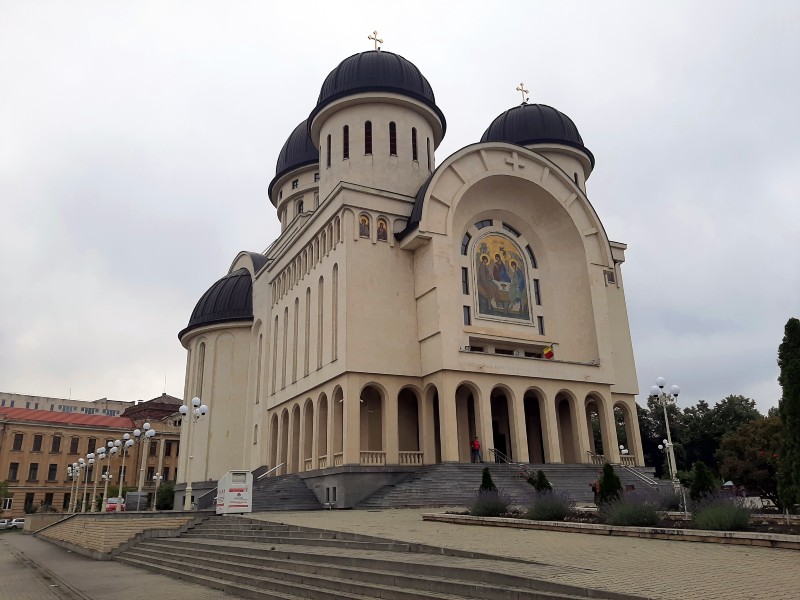

City hall
A good place to start your exploration is Arad’s eclectic city hall which combines neoclassical with neo-Renaissance styles. The tall white tower of the city hall can be seen from all over the old town.
If you stand in front of the city hall do not forget to look down, as Arad’s coat of arms is beautifully painted on the sidewalk’s tilework.
At this point, you are basically standing smack bang in the middle of the old town. There are plenty of other old architectural gems around you, such as the neo-Classical National Bank building and the neo-Renaissance Cenad Palace. Also Arad’s Aurel Vlaicu University is located right next to the city hall.
No matter the direction you walk, you will find plenty of shops, cafes and restaurants around you.







Theatres and churches
If you walk down further south along Bulevardul Revoluţiei you will end up at a major traffic roundabout around which you can find a few of Arad’s other main sights.
One of these is the Roman Catholic St. Anthony of Padua Church built in 1904 in neo-Renaissance style, which is mainly visited by the ethnic Hungarian residents of Arad.
At the other end of the roundabout, you can find the neo-Classical Ioan Slavici Theatre.




Art Nouveau
My favourite part of Arad is even further down south along Bulevardul Revoluţiei. At the backside of the Ioan Slavici Theatre you can find Piața Avram Iancu (Avram Iancu Square).
The square, which feels more like a small park with its well-kept lawns and flowerbeds, features a brutalist-style statue commemorating the fallen Romanian war heroes. It’s one of the few communist remnants in the old town – and the lack of similar buildings and objects from the same era without doubt contributes to Arad’s charms.
Sure, if heading into some suburb you will definitely encounter some communist-style apartment blocks, but Arad’s town centre is delightfully void of such ugly architectural styles.
The best part of Avram Iancu Square are the lovely buildings lining the square, many of them being fine examples of Art Nouveau architecture.
Although some buildings look slightly decayed and could use some renovation, you cannot help but feel some hints of the old grandeur of Budapest here.


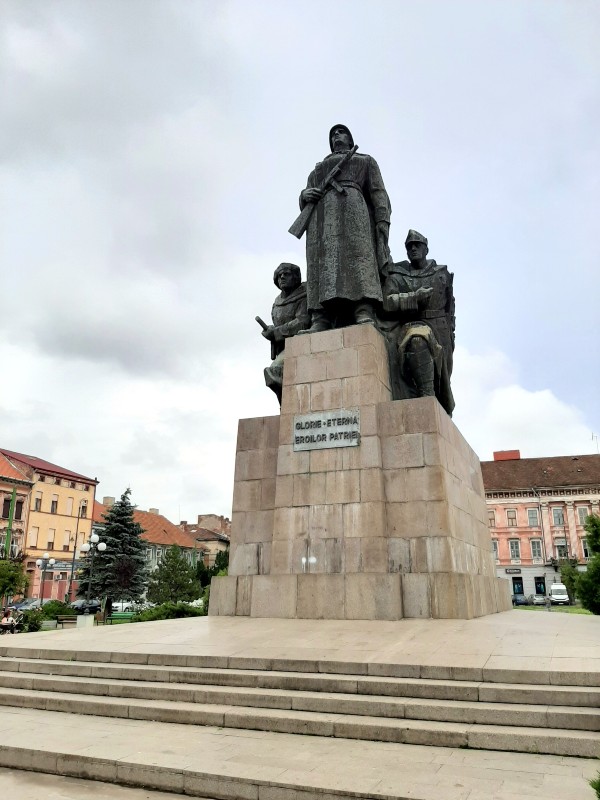







Craft beer
There are plenty of bars and pubs throughout Arad, with many having seating on outdoor terraces during the warm months which generally run from April until late October or even early November.
My favourite place ended up to be a pop-up bar on a side of Avram Iancu Square which was closed off for traffic. Run by Joy’s Café, this bar had lots of Romanian craft beers in the fridge.
Although the ubiquitous beer brands of Ciuc, Timișoreana and Ursus aren’t bad at all, brewing standard European lagers, I hugely prefer the awesome craft beers of Hop Hooligans (from the greater Bucharest area) and Bereta (from nearby Timisoara).
Drinking a great IPA with some lovely Art Nouveau architecture as backdrop was one of the biggest pleasures of Arad.


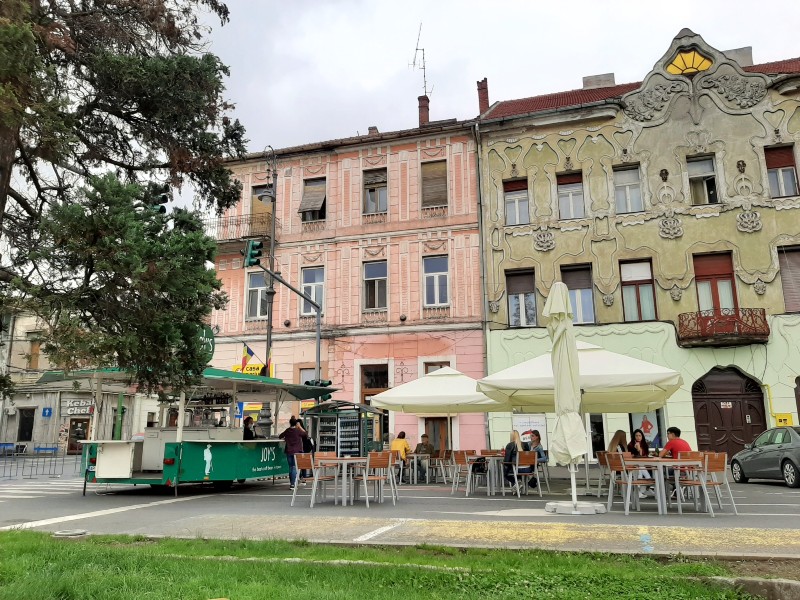
Backstreets
By all means, do not just stick to the main thoroughfares and squares of Arad. Wandering through the backstreets and small alleys brings up plenty more hidden charm, although the thumb of rule is that the further away you go from the main axis of Bulevardul Revoluţie, the more decayed the buildings get.
Some other notable landmarks away from the main streets are the Cultural Palace and the two parks of Parcul Mihai Eminescu and Parcul Copiilor (Children’s Park).







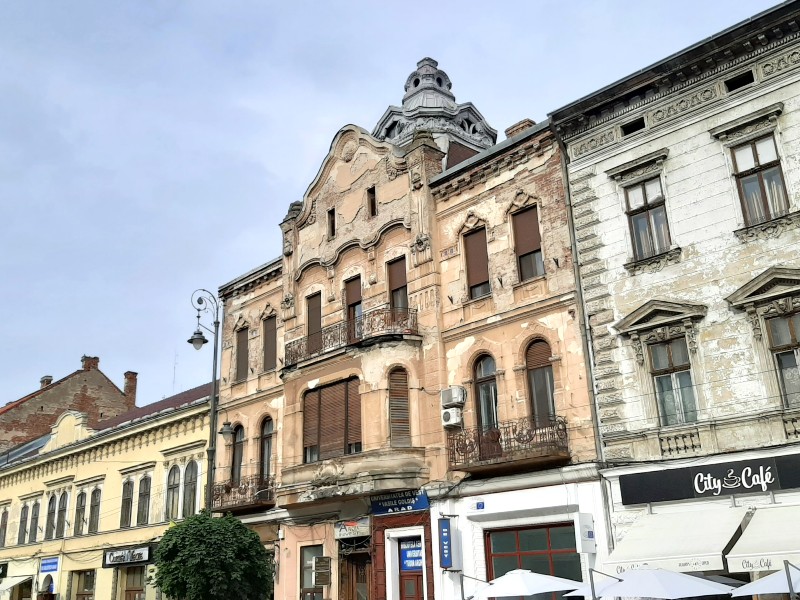


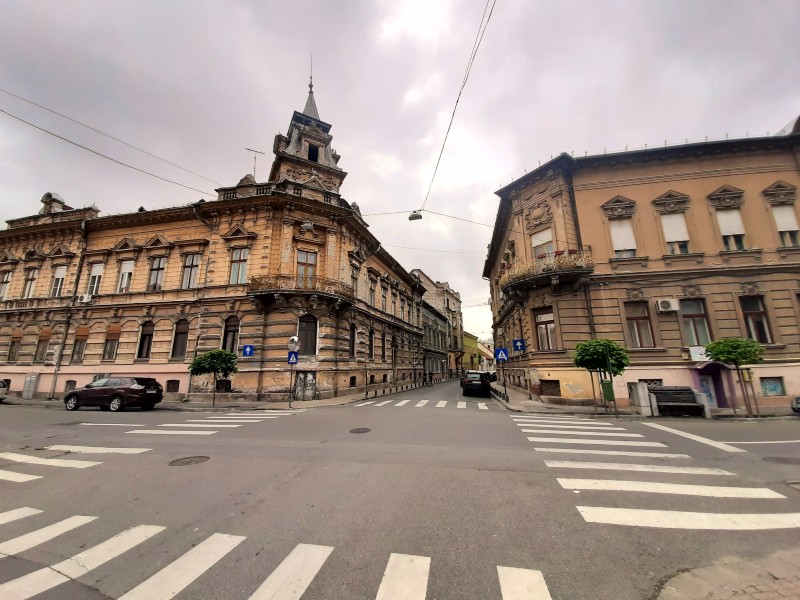
Riverside
Just to the east of the old town of Arad streams the River Mureș, one of Romania’s main rivers which eventually joins the River Tisza in the Hungarian city of Szeged, which in turns eventually flows into the Danube.
When the weather is sunny, the promenade along the river makes for an excellent walk. There are also a handful of summer terraces and restaurants to be found on the river banks.


Arad Fortress
At the other side of the river you can find the Cetatea Aradului (Arad Fortress), a typical Habsburg fortress built in the shape of a hexagram.
Although most of the fortifications and buildings have since been demolished, decayed or overgrown by vegetation, it still makes for a great area of town to have a walk.

Dinner
Back over the river in the old town, Euphoria Biergarten is one of my favourite places in Arad to eat. Originally from the city of Cluj, this popular restaurant has since expanded to Arad and Oradea as well.
Offering al-fresco dining on the street or interior courtyard, this gastropub makes for a nice place to eat a pizza, pasta, meats or other dishes from the extensive menu.
In the direct environs of Euphoria, there are plenty of other restaurants which are well-worth seeking out such as Curtea Veche. Given Arad’s student population, there are also plenty of nightspots such as pubs and clubs around this area of town.


Where to stay in Arad?
The top hotel in Arad is probably the Best Western Central Hotel, which indeed has a highly central location in the old town. Hotel Continental Forum is another big city centre hotel.
During my time in Arad, I stayed at Hotel Coandi in the suburbs of town. Although it was a short walk (or tram ride) from the old town, I liked the riverside terrace and renovated rooms.
Hotel prices are affordable in Arad, with the top hotels such as the Best Western, Continental Forum and ibis Styles unlikely to charge more than 60 to 70 euro per night for a room. If you are on a budget, there are also plenty of cheap hotels, apartments and pensions for around the 25 euro mark.





Getting around Arad
The city centre of Arad is compact enough to explore by foot, although you might need to use public transport or a taxi to head to the train station or hotel.
Arad has an extensive tram network for a town its size, with trams 1, 3 and 6 linking the train station with the old town centre. Buy a ticket from a kiosk, small grocery store or ticket machine.
Taxis are cheap and plentiful in Arad. Make sure the meter is turned on before setting off. Any ride in town is likely to cost only a few euros.



What to see around Arad
There is plenty to see and do around Arad. Although the cities of Timisoara (1 hour) and Oradea (2 hours) are close enough to do as a day trip, I would however recommend to stay at least a night there, as I don’t think a day trip would do these cities justice.
Instead, my day trip recommendation would be to take a train to the town of Radna, just an hour out of Arad. From Radna’s railway station, lovely Maria Radna Church and Monastery is just a short walk away, as are the scenic fortress ruins of Cetatea Șoimoș.
Both can be easily combined as a day trip from Arad, although it is smart to look up train times in advance with national train company CFR, as the schedule can be a bit thin at some parts of the day. Train tickets can easily be bought online or at the train station on the spot.
Another interesting sight in the region are the hilltop castle ruins of Cetatea Șiria. Trains to Șiria are not operated by CFR but by Regio Calatori. Also here, train tickets can be bought online in advance or at the station on the spot.



How to reach Arad
Arad has its own airport just outside the city, although it is currently not served by any scheduled flight. If flight service does return, do not expect much, as even in the ‘heydays’ there were only a handful low-cost flights to destinations such as Milan Bergamo.
Most people visiting Arad fly to bigger regional airports, with Timisoara being the one which is closest by, even having a direct bus connection to Arad.
From Timisoara, there are low-cost flights with Ryanair and Wizz Air to destinations all over Europe, while both Lufthansa and TAROM offer connecting flights through their hubs of Frankfurt, Munich and Bucharest.
Oradea and Sibiu are two other regional airports which are not too far away from Arad. The nearest major international airport is Budapest, with Bucharest being quite a bit further away.
Bus and train
Given that there are currently no scheduled flights to Arad, chances are that you will arrive by bus or train (unless you are driving yourself). For bus connections, Autogari.ro is your one-stop website to check timetables and fares – both for domestic routes as well as international routes to Hungary.
Arad is located on a major rail link, with lines radiating out north to Oradea and Cluj-Napoca, east to Deva and Sibiu, south to Timisoara and Bucharest, as well as west over the Hungarian border to Budapest and Vienna in Austria.
When travelling to or from destinations further afield such as Vienna, Bucharest, Cluj-Napoca and Iași, you can often choose between daytime trains or overnight trains with couchette berths or even proper private sleeping cabins.
For intercity trains within Romania, check the website of the Romanian Railways (CFR) for both timetables and online e-tickets. If heading from Arad to Hungary, you can book your tickets online through the international website of CFR, although there is a chance that you would still need to pick up your actual paper ticket from the station.
When heading from Budapest or any other city in Hungary to Arad, you can buy tickets in advance through the Hungarian Railways (MAV) website, although these still need to be picked up from Hungarian ticket offices or machines as well.
If you are heading to Bucharest from Arad, an interesting alternative to the trains by national railway operator CFR is the privately-run Astra Trans Carpatic overnight train, which arguably is of much higher quality even though the ticket price is the same.





In short
Although Arad might lack blockbuster sights and feels a bit provincial compared to the major Romanian cities such as Cluj, Timisoara and Bucharest, it is certainly a city that will grow on you.
With its Central European Habsburg charm, Arad feels at time likes a little version of Budapest, although more like a Budapest which has been forgotten by time and left in a slightly decayed state.
If you love the old architecture from the turn of the century such as Art Nouveau, you’d probably love wandering aimlessly around town. Arad packs a huge amount of different architectural styles and the old town hasn’t been ruined by ugly communist monstrosities, which makes it easy to grab the vibe of bygone years.
With some good places for food and drinks and highly affordable prices, it also makes for an excellent destination to take it easy for a while.
Good transport links to Romanian cities such as Sibiu, Bucharest, Cluj-Napoca and Timisoara, as well as Budapest in Hungary, means that Arad is easy to include on any itinerary through Central and Eastern Europe.
I really enjoyed my stay in Arad and can highly recommend the city to anyone travelling in the wider region!
Explore some other destinations with us!
In our trip report section, we have written multiple diary accounts of holidays across the world which can serve as an inspiration for your next trip. These trip reports include destination guides such as this article, as well as reviews of hotels, airlines and other modes of transport.
Our previous featured destinations highlighted the Kathmandu Valley and Lecco and Varenna on the shores of Lake Como in Italy.
At Paliparan, we also regularly publish amazing flight deals and special ticket sales, so make sure to regularly check the flight deals section on our website.
Or subscribe to our Facebook, Instagram or Twitter pages to receive instant updates when a new article or flight deal is out!


Thank you for remembering the Hungarian minority.